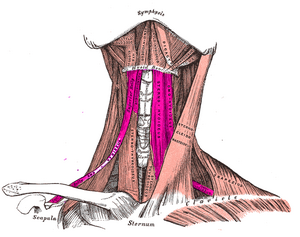Infrahyoid Muscles
Original Editor - User Name
Top Contributors - Areeba Raja, Manisha Shrestha and Nupur Smit Shah
Introduction[edit | edit source]
Infrahyoid muscles are also known as “strap muscles” which connect hyoid, sternum, clavicle and scapula. They are located below the hyoid bone on the anterolateral surface of the thyroid gland(1) and are involved in movements of the hyoid bone and thyroid cartilage during vocalization, swallowing and mastication. They are composed of four paired muscles, organized into two layers as following :[1][2][1]
- Superficial layer
- Deep layer
Superficial layer[edit | edit source]
The superficial layer consists of the following muscles:[2]
- Sternohyoid
- Omohyoid
Sternohyoid[1][2][edit | edit source]
It is a thin, narrow strap and lies anterior to the remaining strap muscles and the thyroid gland.
Origin:[edit | edit source]
It originates from the posterior surface of the medial end of the clavicle, the posterior sternoclavicular ligament and the upper posterior aspect of the manubrium sterni.
Insertion:[edit | edit source]
It inserts at the inferior border of the body of the hyoid bone
Nerve Supply:[edit | edit source]
it is innervated by branches of ansa cervicalis (C1, C2, and C3).
Arterial Supply:[edit | edit source]
It arterial supply comes from the branches of superior thyroid artery. (An anatomical study of the arterial and nerve supply of the infrahyoid muscles)
Action[edit | edit source]
It depresses the hyoid bone after it has been elevated
Variation[edit | edit source]
It may be absent or double, augmented by clavicle slip (cleidohyoid), or interrupted by a tendinous intersection.
Omohyoid[1][2][edit | edit source]
The omohyoid muscle is found deep in the sternocleidomastoid and consist of two bellies (superior and inferior) united at an angle by an intermediate tendon.
Superior Belly[edit | edit source]
Origin:[edit | edit source]
It begins at the intermediate tendon
Insertion:[edit | edit source]
It inserts to the lower border of the hyoid bone
Nerve Supply:[edit | edit source]
It is innervated by the superior ramus of the ansa cervicalis and from hypoglossal nerve.
variation[edit | edit source]
It can be absent or double; It is sometimes fused with sternohyoid.
Inferior Belly[edit | edit source]
Origin:[edit | edit source]
It arises from the upper border of the scapula near the scapular notch and occasionally from superior transverse scapular ligament
Insertion:[edit | edit source]
It inserts into the intermediate tendon
Nerve Supply:[edit | edit source]
It is supplied by ansa cervicalis (C1, C2 and C3)
Variation:[edit | edit source]
It can be absent or double; it may be attached directly to the clavicle
Arterial Supply:[edit | edit source]
It is supplied by superior thyroid and lingual arteries(An anatomical study of the arterial and nerve supply of the infrahyoid muscles)
Action:[edit | edit source]
- It depresses the hyoid bone after it has been elevated.
- It tenses the lower part of the deep cervical fascia in prolonged inspiratory effort, reducing the tendency for soft parts to be sucked inward.
Deep layer[edit | edit source]
The deep layer consists of the following muscles:[2]
- Sternothyroid
- Thyrohyoid
Sternothyroid[1][2][3][edit | edit source]
It is shorter and wider than sternohyoid and contacts the anterior surface of the thyroid gland.
Origin:[edit | edit source]
It arises from the posterior surface of the manubrium sterni and from the posterior edge of the first rib
Insertion:[edit | edit source]
It insert into the oblique line of the thyroid cartilage.
Nerve Supply:[edit | edit source]
It is innervated by branches of ansa cervicalis.
Arterial Supply:[edit | edit source]
It is supplied by superior thyroid and lingual arteries.
Action:[edit | edit source]
- It draws the larynx downwards after it has been elevated by swallowing or vocal movements.
- In low notes singing, this downward traction would be exerted with hyoid bone relatively fixed.
Variation:[edit | edit source]
An accessory belly can be present.
Thyrohyoid[1][2][edit | edit source]
It is a small quadrilateral muscle that may be regarded as an upward continuation of the sternothyroid muscle.
Origin:[edit | edit source]
the oblique line on the lamina of the thyroid cartilage.
Insertion:[edit | edit source]
attaches to the lower border of the greater cornu and adjacent part of the body of the hyoid bone.
Innervation:[edit | edit source]
It is innervated by fibers of the first cervical spinal nerve which branch of the hypoglossal nerve beyond the descendens hypoglossi.
Arterial Supply:[edit | edit source]
It is supplied by superior thyroid and lingual arteries.
Action[edit | edit source]
- it depresses the hyoid bone.
- when the high notes are sung it the thyrohyoid muscle pulls the larynx upwards with the hyoid bone stabilized.
Resources[edit | edit source]
- bulleted list
- x
or
- numbered list
- x
References[edit | edit source]
- ↑ 1.0 1.1 1.2 1.3 1.4 1.5 Allen, Evan, and Abbey Fingeret. “Anatomy, Head and Neck, Thyroid.” Nih.gov, StatPearls Publishing, 26 July 2021, www.ncbi.nlm.nih.gov/books/NBK470452/. Accessed 1 Feb. 2022.
- ↑ 2.0 2.1 2.2 2.3 2.4 2.5 2.6 Gray's anatomy : the anatomical basis of clinical practice. 2005. Neck. Muscles.
- ↑ Kang, Dong Wan, et al. “An Accessory Belly of the Sternothyroid Muscle on the Anterior Neck.” Surgical and Radiologic Anatomy, vol. 37, no. 2, 17 Apr. 2014, pp. 215–217, Accessed 2 Feb. 2022.







